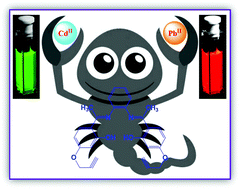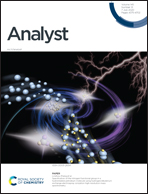Biocompatible alkyne arms containing Schiff base fluorescence indicator for dual detection of CdII and PbII at physiological pH and its application to live cell imaging†
Abstract
An alkyne arms containing salen-type Schiff base ligand, 6,6′-((1E,1′E)-(1,2-phenylenebis(azanylylidene))bis(ethan-1-yl-1-ylidene))bis(3-(prop-2-yn-1-yloxy)phenol) (H2L), is reported here as a dual chemosensor for CdII and PbII ions. The ligand H2L was characterized by various spectral methods. The ligand H2L acts as a dual sensor for CdII and PbII in methanol/HEPES buffer (5 mM, pH 7.3; 1 : 9 v/v) at room temperature with well-separated excitation and emission wavelengths. The emission intensity at 553 nm of H2L is shifted and a new band appeared at 578 nm with the increase in the presence of CdII when it is excited at 420 nm. With excitation at 410 nm, the emission intensity of H2L at 485 nm shifted and a new band appeared at 505 nm with the increase in the presence of PbII. The quantum yield of H2L increases considerably in the presence of CdII and PbII. The compound H2L is non-fluorescent; however, in the presence of CdII and PbII, the compound H2L is highly fluorescent with well-separated excitation and emission wavelengths, indicating that the metal ion is coordinated through phenolic oxygen and imine nitrogen of the Schiff base blocking the PET (Photoinduced Electron Transfer) process and stimulating the CHEF (Chelation Enhanced Fluorescence) process, to increase the fluorescence intensity of H2L. The detection limit values of H2L are in a nano-molar range for both metal ions, confirming very high sensitivity of H2L. The L·MII binding mode and the recognition mechanism of the sensor were explored by Job's plot, 1H NMR, FT-IR, pH and DFT calculations. Besides, H2L was successfully utilized in cell imaging studies for both metal ions in MCF 7 cells.


 Please wait while we load your content...
Please wait while we load your content...